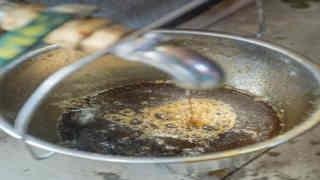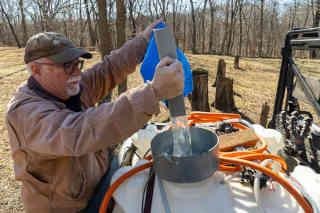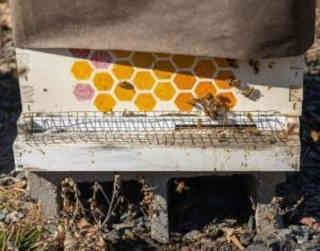The maple syrup season is brief but demanding. It is a race against time with specific weather conditions required to jump start the season. It then lasts until the trees start blooming and the tree frogs start croaking, bringing the season to a screeching halt.
Over the course of the roughly four-week season Hines and his helpers will collect between 3,500 and 4,500 gallons of sap from the trees throughout his property. Then using a mix of technology and good ole’ fashion firewood they will turn it into about 50 gallons of maple syrup. About 300 of the trees are connected to a gravity line system that collects the sap which is pumped uphill to the sugar shack where they make the syrup, but the rest of the sap must be collected manually with bags or barrels.

Despite the hours required to make the syrup and the investments he has made over the last 15 years, Hines said syrup production remains more of a hobby than a business for him and his friends. Most of the syrup they produced is donated to fundraisers and the proceeds from what they do sell are, in turn, donated. It is not money they are after, but the pure enjoyment of the woods and each other’s company.
That was Hines’ goal when he and his wife Jean purchased the property in 1991 after Hines spotted it from his canoe during a trip down the nearby river. They cold called the owner, convinced her to sell and after building a house on the secluded plot of undeveloped land immediately started turning it into their private retreat.
“It's forest and it's all unspoiled,” Hines said. “It had never been occupied. So, wildlife, woodland, privacy, it is a peaceful place to be for the most part.”
Soon after purchasing the property, Hines enrolled it in the Classified Forest and Wildlands Habitat Program through Indiana’s Department of Natural Resources and started working with a district forester to manage the property to help build wildlife habitat and prepare it for a future timber harvest.
They removed invasive species, planted about 500 black walnut trees to increase diversity and thinned some trees to allow the walnuts and maples to flourish. It is a young forest, so a timber harvest is still years away, Hines said.
For the first decade and a half owning the property they mostly utilized the forest for hunting and fishing. Then, during an annual visit through the DNR program a forester recommended they try making maple syrup due to the high number of sugar maple trees on the property. Intrigued by the opportunity, Hines tapped a few trees and started boiling.
“Like a lot of folks, we got a turkey fryer and tapped three trees and collect some sap and boil it down,” Hines said. “You get something that kind of tastes like maple syrup. It was fun to do.”

The next year, they increased to 10 trees, then 30 and eventually 50 after which they decided to build the sugar shack to make the boiling process easier. After the sugar shack was built, the operation rapidly expanded going from 50 tapped trees to 500 in only a few years.
They have since added beehives that produce honey and beeswax for products like candles and boot polish. The bees and syrup operation work in concert and fit perfectly in Hines’ plan to manage and improve the property for the future, while also enjoying the land he owns.
As the maple syrup operation grew, Hines began looking for ways to improve his land to help the forest while also making the work they were doing easier. To help in that process, he turned to USDA’s Natural Resources Conservation Service (NRCS), which he had heard of from his district forester.

He reached out for the first time in 2014 and applied for the Environmental Quality Incentives Program (EQIP) for assistance building trails and landings throughout his forest and cost share assistance for brush management practices to combat invasive species such as bush honeysuckle and multifloral rose.
His contract began in 2015 and included financial and technical assistance to build trails that would help reduce the risk of erosion and three years of brush management assistance on 33 acres of his property. The trails go throughout his property and protect the ecosystem as Hines and his friends traverse the land to tap trees, collect sap or perform other activities in the woods. The trails also include waterbars to help reduce erosion from flowing water. The brush management assistance enabled Hines to continue his long-term commitment to combatting invasive species on the land and improve the overall health of the forest.
“We have benefited from the participation in these programs in a major way,” Hines said. “The trails and landings project was a typical illustration where we're getting some direct support, some engineering support that tells us exactly how to build the trails. What the steepest angles can be. How to get the water off the trailways and landings so that we don't have any erosion issues. The proof is out there.”
He applied for a second EQIP contract in 2017 to develop a forest management plan and then entered into Conservation Stewardship Program (CSP) contracts in 2018 and 2023 for forests stand improvement, tree and shrub restoration, and the development of songbird habitat. The work done through those contracts played a major role in Springboro Farms receiving the 2021 Charles Deam Forest Stewardship award by the Indiana Forestry & Woodland Owners Association, Hines said.

Producing maple syrup is inherently nondestructive, Hines said, and gives them incentive to protect the trees they utilize and encourage their continued growth through good management practices. The Indiana Maple Syrup Association also started a campaign to encourage Indiana maple syrup producers to go a step further and manage their forests not just to maximize syrup production but to promote diverse forest and bird friendly habitat.
“We heard about that, and we thought it was a good idea but then we asked ourselves, ‘What could we do to make it something that we really do, not just something we say because we make maple syrup,’” Hines said. “How can we get proactive and really make Springboro Tree Farms a truly bird friendly place?”
That commitment led him back to NRCS for assistance and to the forest songbird habitat maintenance enhancement through CSP. The work through that program begins this year and Hines has also supplemented it by enrolling in the Forestry for the Birds initiative through the Indiana chapter of The Nature Conservancy. The program identified a “birders dozen” of 13 birds that are native to Indiana and who’s populations need increased habitat.

Through CSP’s songbird enhancement, Hines will work with a forester to assess his land as it currently stands. The program also requires a census of the current bird population on his land, which Hines has chosen to have done by birders from the Sycamore Audubon Society in West Lafayette. The forester will then develop a tailored conservation plan for Hines land to promote the development of habitat for the identified birds with the goal of increasing their populations. Hines will implement that plan utilizing the CSP funding and then in three years birders from the Audubon Society will reconduct the census and track the improvements.
“Maple syrup fits in perfectly because maple syrup doesn't impact in any way the habitat for birds,” Hines said. “When you think about what we do, there's just a few weeks out of the year, about three or four weeks of the year, when we're in the woods and it's not during the nesting season. It's prior to it. So, we leave the forest for the birds when they're here and it's for us and for making maple syrup when they're not.”
As March inches closer and spring temperatures start to make occasional appearances, the forest is all about maple syrup. After the tapping process is complete and the sap begins to collect in large tanks behind the sugar shack a multi-stage process begins to turn the clear sap into rich brown syrup. The sap natively has a sugar content of about 2%, but the final syrup product is 67% sugar. That percentage is raised by removing water and condensing the sap.
With no technological assistance it would take them about 50 hours of managed boiling over a wood-fueled fire to turn 500 gallons of sap into about seven gallons of syrup, said Joe Velovitch, Hines’ friend who helps make the syrup.
They have worked to add technology to reduce that boiling time and by running the raw sap through a reverse osmosis machine twice before boiling they reduce the necessary time to a more manageable 12 hours per seven gallons of finishes product. Hines purchased the machine on his own dime, but because of the energy savings inherent in the time reduction, NRCS now has programs available to help maple syrup producers conduct energy audits and purchase the machines for their operations. NRCS will also help fund a preheater for the evaporator used in syrup production, which Hines said they are considering applying for in the future.
“I think we all enjoy trying to do it like the big guys do it only smaller,” Hines said. “Big guys have a great big reverse osmosis machine. We've got a little reverse osmosis machine.”
It is all part of Hines’ mantra to pursue everything he does with “excellence.” Whether that is the products they produce or the way he manages his forest. But it is also about creating a place where he, his brother and his friends can enjoy the outdoors. After the maple season ends, they will start working with the bees and the orchard they planted on the land. Then in the fall they will hunt deer in the woods before ramping up syrup production again in the throes of winter.
“There's always something going on here,” Hines says sitting in a sugar shack warmed by a fire beneath the evaporator as the steam, the sweet smell of cooking syrup fills the air and his dream for the land fulfilled.
Source : usda.gov